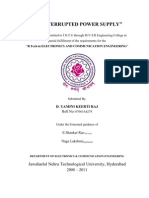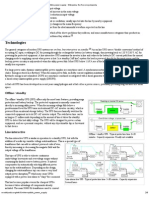Power Conditioner
Power Conditioner
Uploaded by
Paola AlidioCopyright:
Available Formats
Power Conditioner
Power Conditioner
Uploaded by
Paola AlidioOriginal Description:
Copyright
Available Formats
Share this document
Did you find this document useful?
Is this content inappropriate?
Copyright:
Available Formats
Power Conditioner
Power Conditioner
Uploaded by
Paola AlidioCopyright:
Available Formats
POWER CONDITIONER && UNINTERRUPTIBLE POWER SUPPLY Group 8
UPS FUNCTIONS
The primary purpose of a UPS is to provide conditioned, continuous power to its load. Another UPS function that is of
growing importance in todays market is system integration, or the ability to communicate over a network to facilitate the
monitoring and orderly shutdown of loads.
1. Power conditioning
- A UPS provides continuous, regulated power to its load, under all conditions of the utility power
line. Unlike other types of power conditioning equipment, a UPS provides power during outages.
Typically, a UPS will provide backup power for 10 or 15 min, although longer times are possible
with large battery strings or a DC generator.
- A UPS will also correct for high- and low-voltage events, known as surges and sags. This regulation
is provided either electronically or by a tapped transformer or a Ferro resonant transformer.
2. System integration
- The industrial electronics environment is very similar to the typical office LAN/WAN environment
when it comes to using a UPS to provide power protection for industrial-grade PCs, PLCs and other
equipment that make use of any form of microprocessor control.
UPS integration- communication between UPS and the load equipment.
These methods may be classified into three integration categories:
A. Basic - The first and most common integration method communicates the status of the UPS via
contact closures. Typically, normally open or normally closed relay contacts are used to signal two
UPS conditions to the load equipment. These conditions are AC Failure and Low Battery.
AC Failure - should be signalled by the UPS whenever a power failure condition exists for more than 5 sec.
Low Battery - signal exists when a minimum of 2 min of battery runtime remains to support the load. However,
most UPS manufacturers allow this set point to be programmed by the user to allow more time to shutdown the system.
B. Enhanced - To provide more than just the basic UPS status information, many UPS manufacturers
have chosen to offer RS232 and other forms of serial communication that allow real-time UPS data
to be monitored by software running on the load equipment. Instead of knowing only that a power
failure has occurred or that a low battery condition exists, the user may now know how much
calculated runtime is available and the measured battery voltage at any given time. Other data values
are typically available that represent the input and output voltage, percent of full load, UPS
temperature, as well as many others.
C. Network - The size and complexity of todays local and wide area networks has led to an increase in
the use of network management tools to monitor and control network devices. The Simple Network
Management Protocol (SNMP) has become the de facto standard for network management and is
backed by many network management software products.
STATIC UPS TOPOLOGIES - A static UPS is one that relies on power electronics, rather than a motor generator,
to provide power to the load. Most UPSs today are of this type. The terms on-line UPS and off-line UPS
have commonly been used to describe some UPS topologies. Unfortunately, UPS manufacturers have not been
able to agree on the meanings of these terms, leading to confusion among users. Terms which are more
descriptive of the differences between various topologies are double-conversion UPS, line-interactive UPS, and
standby power supply.
1. Double Conversion UPS - first rectifies incoming AC
line to a DC voltage, then inverts that DC voltage to
provide an AC output. During normal operation, the
rectifier is providing current to charge the batteries and
also to the inverter. The inverter supports the load and
provides regulation of the output voltage and frequency.
2. Line-interactive UPS - In normal operation, the AC input
passes through a filter or transformer to the load. The inverter
is normally not supporting the entire load, but may be used to
buck or boost the line voltage, or even fill in notches of the
incoming line voltage waveform on a sub-cycle basis. It is
this ability of the inverter to interact with line that gives the
line-interactive UPS its name. The inverter does not support
the load unless there is a power outage, or the AC input falls
outside the specified voltage and frequency tolerances.
3. Standby PS - are not properly called UPS because they do
not provide continuous power to the load. A standby power
supply is similar to a line interactive UPS in that the inverter
is not normally supporting the load. However, when the load
is transferred from line to inverter, an interruption in power
occurs due to the break time of the transfer switch.
Alternate AC && DC Sources
1. Batteries - Both flooded and valve-regulated lead acid (VRLA) batteries are commonly used in UPS
applications. VRLA batteries have become increasingly popular in the last few years because of their
relative ease of installation and maintenance.
Factors affecting battery life: the charging method, the number of discharge cycles, the depth of discharge, the rate of
discharge, the ripple voltage across the battery terminals.
Sulfation - is the formation of lead sulfate on the battery plates.
2. DC Generators - To a great extent, the DC generator of today has changed from the days of
maintenance-intensive brushes and commutators to highly efficient rectified systems. Now, instead of
relying on the brush and commutator to perform the rectification process, AC alternators and diodes are
used to produce near battery quality DC power.
Telecommunications applications such as remote offices and cellular radio sites also enjoy the
reliability of DC power generation.
3. Superconducting Magnetic Energy Storage - (SMES) systems are relative newcomers to the field of
backup power systems. SMES systems store DC energy in a superconducting magnetic coil. The
niobium-titanium coil is cooled by liquid helium to 4.2 K or by superfluid helium to 1.8 K.
4. AC Generators - For many applications where the AC line quality is unimportant, the AC generator is
still a viable alternative for extended-run applications. With the potentially unlimited runtimes
obtainable, the AC generator is certainly attractive. But with todays more sensitive loads, the AC
generator may not be the best solution.
You might also like
- Digital Marketing in The Automotive Electronics Industry: Uli Schneider Jürgen Hoika EditorsDocument249 pagesDigital Marketing in The Automotive Electronics Industry: Uli Schneider Jürgen Hoika EditorsWalterNo ratings yet
- Automated Broad and Narrow Band Impedance Matching for RF and Microwave CircuitsFrom EverandAutomated Broad and Narrow Band Impedance Matching for RF and Microwave CircuitsNo ratings yet
- Offline Ups Project Report Front 31 Pages RemakeDocument33 pagesOffline Ups Project Report Front 31 Pages Remakeprashanta padhiary100% (1)
- An Integrative Teaching-Learning Model in Counselor EducationDocument11 pagesAn Integrative Teaching-Learning Model in Counselor EducationAzmira Aina Mohd ArifNo ratings yet
- Soal Soal ToeicDocument8 pagesSoal Soal ToeicJihan Rosa Khairunnisa0% (1)
- Design Construction of One Uninterruptible Power Supply (UPS)Document25 pagesDesign Construction of One Uninterruptible Power Supply (UPS)Suva nilNo ratings yet
- Uninterruptible Power SupplyDocument12 pagesUninterruptible Power SupplyJameer AsifNo ratings yet
- Uninterruptible Power Supply - WikipediaDocument82 pagesUninterruptible Power Supply - WikipediaKalimbwe TutaNo ratings yet
- Uninterruptible Power Supply and InvertersDocument10 pagesUninterruptible Power Supply and InvertersnicenezaNo ratings yet
- UPS Topologies & StandardsDocument11 pagesUPS Topologies & StandardsMuhammad BaihaqiNo ratings yet
- Baterias para UPS PDFDocument10 pagesBaterias para UPS PDFcarlosalbertocamargoNo ratings yet
- Uninterruptible Power SupplyDocument16 pagesUninterruptible Power SupplyorlandochavezmoraNo ratings yet
- Uninterrupted Power Supply ArticleDocument14 pagesUninterrupted Power Supply ArticlechukwunemeNo ratings yet
- UpsDocument27 pagesUpsmatthew02012010No ratings yet
- UPS Project NewDocument34 pagesUPS Project NewKrishna RajNo ratings yet
- Which UPS Is Right For The Job PDFDocument15 pagesWhich UPS Is Right For The Job PDFMeNo ratings yet
- Preparation of Papers For IEEE T M (Revised May 2015) : Ransactions ON AgneticsDocument5 pagesPreparation of Papers For IEEE T M (Revised May 2015) : Ransactions ON Agneticshkparmar003No ratings yet
- Power Ups PDFDocument7 pagesPower Ups PDFtsraj10100% (1)
- High Power Ups Selection Methodology and Installation Guideline For High Reliability Power SupplyDocument7 pagesHigh Power Ups Selection Methodology and Installation Guideline For High Reliability Power SupplyCyriac SebastianNo ratings yet
- Uninterruptable Power SupplyDocument14 pagesUninterruptable Power Supplyjohnsmith7shadowsNo ratings yet
- The Different Types of UPS Systems: White Paper # 1Document9 pagesThe Different Types of UPS Systems: White Paper # 1Serge RINAUDONo ratings yet
- Final of Atif UpsDocument99 pagesFinal of Atif UpsSajid HussainNo ratings yet
- UPSDocument23 pagesUPSbibi57% (7)
- Intelligent Monitoring of Ups System: Under The Guidance ofDocument40 pagesIntelligent Monitoring of Ups System: Under The Guidance ofTushar MenonNo ratings yet
- Static Uninterruptable Power SuppliesDocument6 pagesStatic Uninterruptable Power SuppliesJorge MazorraNo ratings yet
- UPSDocument54 pagesUPSy m d100% (1)
- Selecting Ups SystemDocument4 pagesSelecting Ups SystemB M SinghNo ratings yet
- Uninterruptible Power Supply - Wikipedia, The Free EncyclopediaDocument1 pageUninterruptible Power Supply - Wikipedia, The Free EncyclopediaAnkit DhimanNo ratings yet
- Voltage Power Supplies: Regulation of UninterruptedDocument5 pagesVoltage Power Supplies: Regulation of UninterruptedhuseyinkaksaNo ratings yet
- Technical GlossaryDocument5 pagesTechnical GlossaryKeyboardMan1960No ratings yet
- Uninterruptible Power SupplyDocument3 pagesUninterruptible Power SupplyjancukoeNo ratings yet
- UPS Working Principle TypesDocument11 pagesUPS Working Principle Typeswasif upolNo ratings yet
- Home Inverter & UpsDocument6 pagesHome Inverter & Upspower guardNo ratings yet
- Mouser TL Training ModuleDocument19 pagesMouser TL Training ModulesarahalkhudhayriNo ratings yet
- Tsewg tp19Document24 pagesTsewg tp197xz77bmvqfNo ratings yet
- SMPSDocument30 pagesSMPStulugugayatri73No ratings yet
- The Different Types of UPS SystemsDocument10 pagesThe Different Types of UPS SystemsDavid HicksNo ratings yet
- Power Factor Measurement & Correction: Prepared By: Guided byDocument29 pagesPower Factor Measurement & Correction: Prepared By: Guided bySunil PillaiNo ratings yet
- Ups (Uninterruptible Power Supply) : Disusun OlehDocument18 pagesUps (Uninterruptible Power Supply) : Disusun OlehDevia Rafika PNo ratings yet
- Types of UPS 2Document3 pagesTypes of UPS 2Pedro MauricioNo ratings yet
- Uniterruptible Power Supply SystemDocument8 pagesUniterruptible Power Supply SystemSk The AlternatorNo ratings yet
- Final Project 2022nourDocument41 pagesFinal Project 2022nournour salahNo ratings yet
- 1000w Inverter PURE SINE WAVE Schematic DiagramDocument84 pages1000w Inverter PURE SINE WAVE Schematic DiagramandreboenNo ratings yet
- Technical Comparison of On-Line vs. Line-Interactive UPS DesignsDocument14 pagesTechnical Comparison of On-Line vs. Line-Interactive UPS Designsdrpiratheepan4274No ratings yet
- UPSDocument6 pagesUPSTanmoy AcharyaNo ratings yet
- CAT UPS Topology LEXE0136-00Document6 pagesCAT UPS Topology LEXE0136-00okovalskiNo ratings yet
- Diffrent Types of UPSDocument9 pagesDiffrent Types of UPSAsher KhanNo ratings yet
- Uninterruptible Power SupplyDocument5 pagesUninterruptible Power SupplyddipyenduNo ratings yet
- 1000w Inverter PURE SINE WAVE Schematic DiagramDocument84 pages1000w Inverter PURE SINE WAVE Schematic DiagramPERWANA100% (3)
- Static UPS TechnologyDocument17 pagesStatic UPS Technologyimam116No ratings yet
- Information Sheet # 11: Your Reliable Guide For Power SolutionsDocument2 pagesInformation Sheet # 11: Your Reliable Guide For Power Solutionskhaledmahmoud2483No ratings yet
- Methods for Increasing the Quality and Reliability of Power System Using FACTS DevicesFrom EverandMethods for Increasing the Quality and Reliability of Power System Using FACTS DevicesNo ratings yet
- Reference Guide To Useful Electronic Circuits And Circuit Design Techniques - Part 2From EverandReference Guide To Useful Electronic Circuits And Circuit Design Techniques - Part 2No ratings yet
- Introduction to Power System ProtectionFrom EverandIntroduction to Power System ProtectionRating: 5 out of 5 stars5/5 (1)
- Reference Guide To Useful Electronic Circuits And Circuit Design Techniques - Part 1From EverandReference Guide To Useful Electronic Circuits And Circuit Design Techniques - Part 1Rating: 2.5 out of 5 stars2.5/5 (3)
- It Is Quite Another Electricity: Transmitting by One Wire and Without GroundingFrom EverandIt Is Quite Another Electricity: Transmitting by One Wire and Without GroundingNo ratings yet
- Analog Dialogue Volume 46, Number 1: Analog Dialogue, #5From EverandAnalog Dialogue Volume 46, Number 1: Analog Dialogue, #5Rating: 5 out of 5 stars5/5 (1)
- A Case Study for a Single-Phase Inverter Photovoltaic System of a Three-Bedroom Apartment Located in Alexandria, Egypt: building industry, #0From EverandA Case Study for a Single-Phase Inverter Photovoltaic System of a Three-Bedroom Apartment Located in Alexandria, Egypt: building industry, #0No ratings yet
- Investigation of the Usefulness of the PowerWorld Simulator Program: Developed by "Glover, Overbye & Sarma" in the Solution of Power System ProblemsFrom EverandInvestigation of the Usefulness of the PowerWorld Simulator Program: Developed by "Glover, Overbye & Sarma" in the Solution of Power System ProblemsNo ratings yet
- (최상위) 7.Technology in Our Lives (03) - 동아 (윤정미) 중3 영어 (15문제) (Q) - unlockedDocument8 pages(최상위) 7.Technology in Our Lives (03) - 동아 (윤정미) 중3 영어 (15문제) (Q) - unlockedjihagi8No ratings yet
- Philips FR M 8928444 GC9220Document126 pagesPhilips FR M 8928444 GC9220Bart KleijwegtNo ratings yet
- O GeiteiroDocument5 pagesO Geiteironectarioscasu2020No ratings yet
- Chapter-16 Risk Management PlanningDocument25 pagesChapter-16 Risk Management Planningnsrivastav1No ratings yet
- Lab Report 1Document21 pagesLab Report 1Nor Atikah Abdul Razak71% (17)
- Human Evolution - Ape To ManDocument6 pagesHuman Evolution - Ape To ManAngela Ann GraciaNo ratings yet
- Dark Enlightenment - The Neo-Fascist Philosophy That Underpins Both The Alt-Right and Silicon Valley Technophiles - Quartz PDFDocument6 pagesDark Enlightenment - The Neo-Fascist Philosophy That Underpins Both The Alt-Right and Silicon Valley Technophiles - Quartz PDFJustin Gortva Scheibel0% (1)
- Getting Ready For Exams Student GuideDocument5 pagesGetting Ready For Exams Student Guiderahmanredwan468No ratings yet
- CbeDocument6 pagesCbeKumera Dinkisa ToleraNo ratings yet
- Format For Village ProfilingDocument24 pagesFormat For Village Profilingjasmine.tanejajha67% (3)
- First AssignmentDocument4 pagesFirst AssignmentImran ShahzadNo ratings yet
- A320 New Check List RevisedDocument31 pagesA320 New Check List RevisedSanjeev WadhwaNo ratings yet
- Palliative Care and End-of-Life Decision-Making: Navigating A Complex and Compassionate LandscapeDocument2 pagesPalliative Care and End-of-Life Decision-Making: Navigating A Complex and Compassionate LandscapeInternational Journal of Innovative Science and Research TechnologyNo ratings yet
- Securities and Exchange Commission (SEC) - Formn-27e-1Document2 pagesSecurities and Exchange Commission (SEC) - Formn-27e-1highfinanceNo ratings yet
- Politics of (In) Accessibilities, Citizens With Disabilities and Their AlliesDocument7 pagesPolitics of (In) Accessibilities, Citizens With Disabilities and Their AlliesNie Zofia NierodzińskaNo ratings yet
- BlockbusterDocument26 pagesBlockbusterMian Muhammad HaseebNo ratings yet
- Primary Year 1 SyllabusDocument16 pagesPrimary Year 1 SyllabusPuspa NicholasNo ratings yet
- Elden Ring - GM BinderDocument21 pagesElden Ring - GM Binderhasshin1337No ratings yet
- Tamer AL Shikh Khalil Curriculum Vitae1-3Document2 pagesTamer AL Shikh Khalil Curriculum Vitae1-3aboalshamkhalilNo ratings yet
- Numerical Analysis: Chapter - 6Document30 pagesNumerical Analysis: Chapter - 6Pranay ReddyNo ratings yet
- Speeches by HH Prince Karim Aga Khan (1963 - 2009)Document349 pagesSpeeches by HH Prince Karim Aga Khan (1963 - 2009)Aazar Ali Shad100% (1)
- Project Report: (Online Airline Ticket Reservation System)Document59 pagesProject Report: (Online Airline Ticket Reservation System)Pallavi SrivastavaNo ratings yet
- Professional and Focused Tool of Data Storage: Introduction To Inspur Storage ProductsDocument43 pagesProfessional and Focused Tool of Data Storage: Introduction To Inspur Storage ProductsPandi IndraNo ratings yet
- AlphaESS M48112-SDocument2 pagesAlphaESS M48112-SEben TeyeNo ratings yet
- OWB600719 PS International RoamingDocument25 pagesOWB600719 PS International RoamingJuan Carlos RNo ratings yet
- 5ee81a71b2c966a0cfee8985794b7389Document31 pages5ee81a71b2c966a0cfee8985794b7389phpfoxgNo ratings yet
- The Sounds of Music Sushan KonarDocument11 pagesThe Sounds of Music Sushan KonarVijay SANo ratings yet

























































































